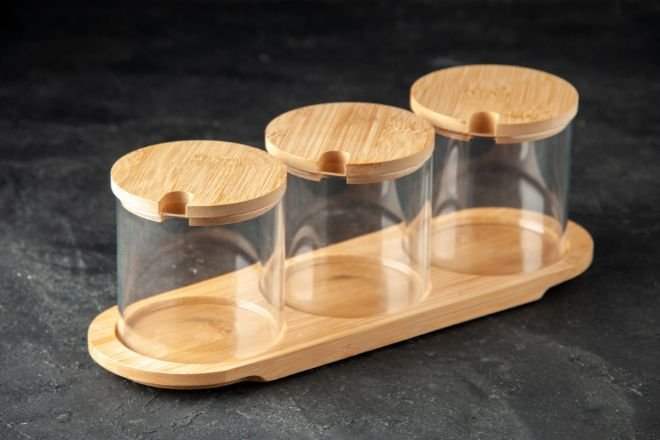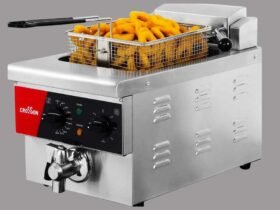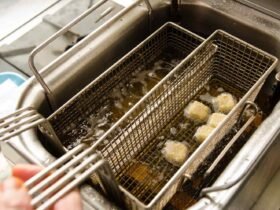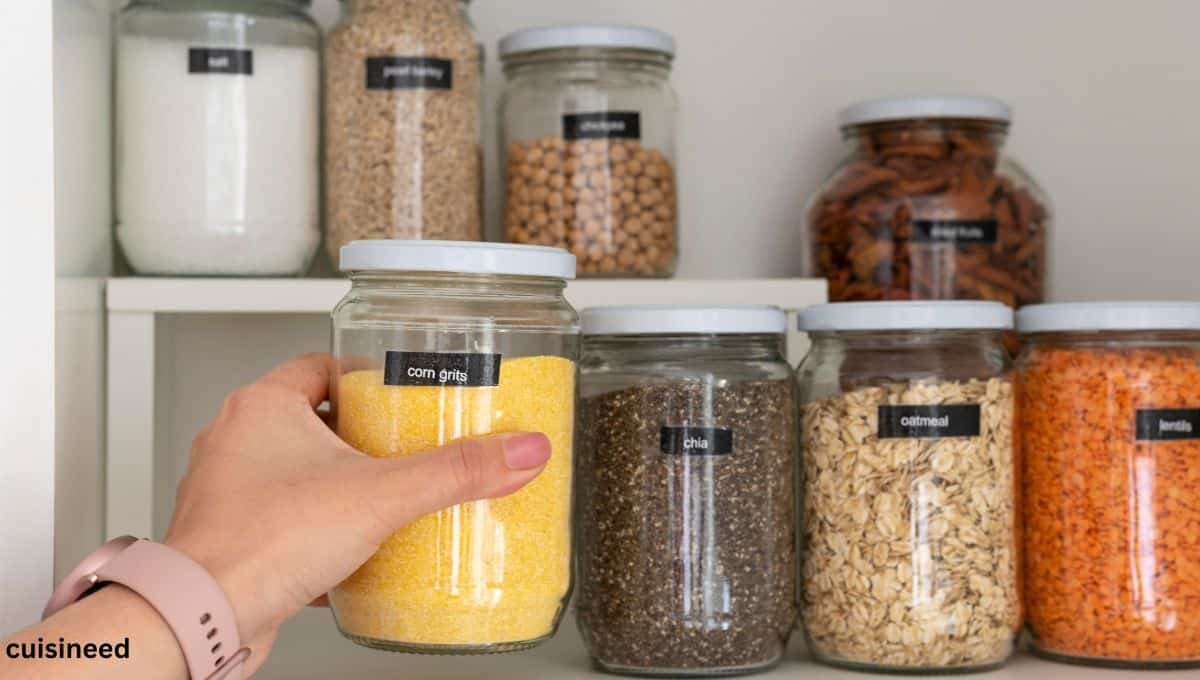Food Saver Containers offer a practical solution for minimizing food waste and maximizing storage efficiency. Their vacuum-sealing capabilities lock in flavour and nutrients, making them a favourite among those who prioritize food preservation. Ideal for both pantry and refrigerator use, these containers come in various sizes to accommodate a range of food items.
Table of Contents
By using Food Saver Containers, households can enjoy the benefits of longer-lasting produce, meats, and dry goods. The containers’ durable design and ease of use make them an essential tool for anyone looking to save money and reduce spoilage in their kitchen.
The Importance Of Food Saver Containers

Food Saver Containers play a vital role in every kitchen. They keep meals fresh and make food last longer. With the right containers, you can prevent spoilage and save money. They are essential for an organized fridge or pantry. Let’s dive into why these containers are so important and how they can change the way you store your food.
Preserving Freshness
Everyone loves the taste of fresh food. Food Saver Containers are designed to seal in that freshness. Whether it’s fruits, veggies, or leftovers, these containers keep air out and flavour in. Here’s how they help:
- Lock in Nutrients: Nutrients stay intact, ensuring healthier meals.
- Prevent Oxidation: They reduce air exposure, stopping brown spots on food like apples and avocados.
The benefits of Food Saver Containers go beyond just keeping food looking good. They also:
| Container Size | Best Use |
| Small | Perfect for nuts or small fruits like berries. |
| Medium | Ideal for single servings or half-cut veggies. |
| Large | Great for meals or large fruit like melon slices. |
Knowing how to use food-saving containers effectively ensures your food remains as fresh as possible. For example, the best food-saver containers for meal prep are airtight and come in various sizes to fit your needs.
Reducing Food Waste
Food Saver Containers are heroes when it comes to reducing waste. Here’s why they’re a smart choice:
- They prolong the life of your groceries, meaning fewer trips to the store.
- They help you see what you have, so you use what you buy.
- They make leftovers more appealing, so you’re more likely to eat them.
With a range of food saver container sizes, you can pick the perfect match for any food item, big or small. This flexibility helps you avoid throwing out unused food. Plus, using these containers for meal prep encourages you to eat home-cooked meals, cutting down on takeout waste. Remember, even small changes in how we store our food can lead to big reductions in waste.
Types Of Food Saver Containers
Keeping food fresh is a task that every kitchen juggles daily. Food-saver containers play a crucial role in this dance of preservation. They come in various types, each with its benefits and uses. Let’s dive into the world of food-saving containers and look at the options available.
Plastic Containers
Plastic containers are a popular choice for food storage due to their lightweight nature and versatility. They are great for both dry and wet foods. Here’s why they stand out:
- Durable: They can withstand drops and knocks without shattering.
- Transparent: Easy to see contents without opening the lid.
- Stackable: Saves space in your fridge or pantry.
When selecting plastic containers, consider BPA-free options for safety. Below is a comparison of common plastic container features:
| Type | Airtight Seal | Microwave Safe | Dishwasher Safe |
| Standard | Yes | Yes | Yes |
| Freezer-Safe | Yes | No | Yes |
Glass Containers
Glass containers are the go-to for those seeking a more sustainable and non-reactive option. They are perfect for reheating and often come with snapping or locking lids to prevent spills. Some key points include:
- Non-porous: They don’t absorb smells or stains.
- Heat Resistant: Ideal for oven use.
- Eco-Friendly: Made from natural materials and recyclable.
Consider the weight and handle with care, as glass can break if dropped. Here’s a quick look at the benefits of glass containers:
| Feature | Benefit |
| Chemical-Free | Safe for storing acidic foods without fear of leaching. |
| Longevity | Does not degrade over time like plastic can. |
Vacuum-sealed Containers
Vacuum-sealed containers offer a superior level of food preservation by removing air that can lead to spoilage. This method is excellent for extending the shelf life of perishables. Here are some perks:
- Longer Freshness: Foods stay fresh for a longer time.
- Flavour Preservation: Sealing locks in taste and aroma.
- Portion Control: Perfect for meal prepping and managing diet.
These containers often require a vacuum-sealing machine, which can be an added cost. Yet, the investment pays off in food savings. Here’s a simple overview of their usage:
| Food Type | Shelf Life Increase |
| Meats | Up to 2-3 years in the freezer |
| Vegetables | Up to 2 weeks in the fridge |
Key Features To Look For
Everyone loves fresh food. Food Saver Containers keep your meals tasty and safe. They come in many sizes. You need to know what features are best. Let’s dive into the key features to look for in Food Saver Containers. These features make sure your food stays fresh longer.
Airtight Seals
An airtight seal is crucial for keeping food fresh. It stops air from getting in. This keeps your food safe from bacteria. Here’s why airtight seals are a must:
- They keep moisture out. This means your food doesn’t get soggy.
- Air can’t get in, so your food stays fresh longer.
- They help keep smells inside. Your fridge stays smelling clean.
Here’s a quick guide on how to use food-saver containers with airtight seals:
- Fill your container but leave some space at the top.
- Press down on the lid until you hear a click. That means it’s sealed.
- Check the sides to make sure the lid is tight all around.
Benefits of food saver containers with airtight seals:
| Benefit | Description |
| Longer Freshness | Food stays fresh for days, not hours. |
| Less Waste | You throw away less food because it lasts longer. |
| Save Money | Buying in bulk is cheaper. With airtight containers, food doesn’t spoil fast. |
Microwave And Dishwasher Safe

Microwave and dishwasher-safe containers save time. Here’s why they’re great:
- You can reheat food in the same container. No need for extra dishes.
- Easy to clean. Just put them in the dishwasher.
Not all containers can go in the microwave or dishwasher. Check the bottom of your container. It should say if it’s safe. This is part of the best food-saver containers for meal prep. You can prep, store, reheat, and clean up easily.
Remember, some foods need special care in the microwave. Always open the container a little to let steam out. This stops food from getting too soggy or drying out.
Stackable Design
Stackable design saves space in your fridge and cabinets. Here’s how:
- Containers fit together. You can stack them high.
- They use less space. This gives you more room for other things.
- It’s easier to find what you need. You can see everything at once.
Food-saver container sizes matter for stacking. Make sure you have a variety. Small ones for sauces and large ones for meals. This way, you can fit any type of food.
Stacking also helps with meal prep. You can organize meals by day. This makes it easy to grab what you need without searching.
Benefits Of Using Food Saver Containers
Keeping food fresh for longer is a common challenge in many households. Food Saver Containers offer a smart solution to this problem. They come with benefits that go beyond just saving leftovers. By using these innovative containers, you’ll enjoy fresher meals, reduce waste, and save money. Let’s explore the advantages of incorporating Food Saver Containers into your daily routine.
Extended Shelf Life
One of the top benefits of Food Saver Containers is their ability to extend the shelf life of food. Here’s how they make a difference:
- Airtight sealing keeps out air and moisture, slowing down the spoilage process.
- They preserve food’s nutritional value for longer periods.
- Prevents freezer burn when used in the freezer, ensuring food remains edible for months.
The table below shows a comparison of shelf life for common foods stored in traditional containers versus Food Saver Containers:
| Food Item | Traditional Container Shelf Life | Food Saver Container Shelf Life |
| Berries | 3-5 days | 1-2 weeks |
| Leftover Pizza | 3-4 days | 1 week |
| Raw Chicken | 1-2 days | 5-6 days |
Notably, are food-saver containers safe for freezer use? Absolutely! They are designed to withstand extreme cold without cracking, further extending your food’s shelf life.
Maintaining Flavor And Quality
Food Saver Containers not only keep food fresh but also maintain its flavour and quality. Here are key points highlighting their effectiveness:
- Locks in taste so your meals remain delicious over time.
- Prevents odour transfer between foods, especially in the fridge.
- Materials used don’t affect the taste of the food stored within.
Food saver container materials are carefully selected to ensure they don’t impart any unwanted flavours into your food. These containers are usually made of high-quality plastics or glass that are food-safe and durable. By using these containers, you can trust that your meals will taste just as good as the day you prepared them.
Convenient Food Storage

Food Saver Containers provide convenient food storage solutions. Their benefits include:
- Stackable design saves space in your fridge, freezer, and pantry.
- Variety of sizes and shapes for all types of food.
- Dishwasher safe for easy cleaning.
These containers also feature see-through walls so you can quickly find what you need without opening multiple containers. Their user-friendly design means they’re easy to open and close, which is perfect for kids and adults alike. With Food Saver Containers, you’ll find organizing your kitchen space a breeze, making meal prep and storage hassle-free.
Tips For Proper Use
Keeping your food fresh for longer is vital for reducing waste and saving money. Food Saver Containers play a crucial role in this mission. To ensure they perform at their best, it’s essential to use them correctly. Let’s dive into some handy tips that will help you make the most out of your Food Saver Containers.
Proper Cleaning And Maintenance
Maintaining the cleanliness and integrity of your Food Saver Containers is a must. Regular cleaning prevents bacterial growth and keeps your containers in top shape. Follow these simple steps:
- Hand wash with warm, soapy water after each use.
- Rinse thoroughly to remove all soap residue.
- Air dry upside down to prevent water spots.
For stubborn stains or odours, try a baking soda paste. Apply it inside the container, let it sit for a few hours, then rinse. Remember, are Food Saver Containers safe for the freezer? Yes, but avoid sudden temperature changes. They can cause cracking or warping. Lastly, check the food saver container materials. Some are dishwasher safe, while others are not. Refer to the manufacturer’s instructions for the best care.
| Container Part | Cleaning Method | Maintenance Tips |
| Lid | Hand wash | Check seals regularly |
| Base | Dishwasher (if applicable) | Avoid abrasive cleaners |
| Seal | Gentle wipe | Replace if worn out |
Optimal Filling Levels
To maximize freshness, it’s important to know how much to fill your containers. Here’s a guide to optimal filling levels:
- Fill to just below the rim to allow for food expansion, especially when freezing.
- For liquids, leave about an inch of headspace to prevent spillovers.
- For dry goods, press down lightly to remove air pockets.
Overfilling can lead to leaks and reduce the effectiveness of the vacuum seal. Underfilling, on the other hand, means excess air inside, which can hasten food spoilage. Use the right size container for the amount of food you have. If you’re unsure, it’s better to size up. Keep in mind that Food Saver Containers are safe for freezer use, but proper filling is key to prevent freezer burn.
Here’s a quick reference for different types of food:
| Type of Food | Optimal Filling Level |
| Liquids | 1 inch below the rim |
| Dry Goods | Press lightly to remove air |
| Freezer Items | Just below the rim |
Always check the material of your container. Not all food saver container materials are created equal. Some may be more suited for certain types of food or storage conditions.
Creative Ways To Use Food Saver Containers

Food Saver Containers are not just for keeping leftovers fresh. These versatile tools can transform the way you store, organize, and prepare your meals. With a bit of creativity, you can unlock new uses for these containers that can save time, reduce waste, and even help you eat healthier. Let’s dive into some innovative ways to utilize Food Saver Containers in your daily life.
Meal Prep And Portion Control
The art of meal prep becomes a breeze with Food Saver Containers. These airtight containers keep your food fresh for longer, ensuring your efforts in the kitchen last throughout the week. Here’s how you can make the most of them:
- Batch Cooking: Cook large portions and divide them into single servings. It helps you resist the temptation to overeat and makes it easy to grab a meal on the go.
- Snack Sorting: Pre-portion nuts, fruits, or veggies so you can enjoy a healthy snack without overindulging.
- Dietary Management: Custom portion sizes can support specific dietary needs, making it simple to follow your meal plan.
| Day | Lunch | Dinner |
| Monday | Chicken Salad | Grilled Salmon |
| Tuesday | Quinoa Bowl | Stir-Fry Veggies |
To buy food-saver containers online, search for the best place to buy food-saver containers and ensure you get a variety of sizes for different needs. You can also look for a food-saving container store near me to see the options in person.
Organizing Pantry And Fridge
A well-organized pantry and fridge can save you time and reduce food waste. Food Saver Containers come to the rescue with their stackable design and clear visibility. Here’s how to use them effectively:
- Labeling: Clearly label each container with its contents and date stored. This practice helps you keep track of what you have and use items before they expire.
- Stackable Storage: Maximize space by stacking containers. It makes your pantry and fridge look neat and keeps everything within easy reach.
- Visibility: With clear containers, you can quickly see what’s inside without opening multiple containers, saving you time and keeping food fresh.
| Container Size | Pantry Items | Fridge Items |
| Small | Spices | Condiments |
| Medium | Grains | Cheese |
| Large | Flour | Leftovers |
Remember, the key to an efficient pantry and fridge is to keep them clutter-free. With Food Saver Containers, you can create a system that works for your lifestyle. Whether you’re trying to buy food-saver containers online or find the best place to buy food-saver containers, start by assessing your storage needs. If you prefer shopping in person, search for a food-saver container store near me to explore your options.
Comparison With Other Food Storage Methods
Food Saver Containers are a smart choice for keeping food fresh longer. They seal out air and lock in flavour. This means your meals stay tasty and waste is cut down. Let’s see how they stack up against other popular storage methods.
Versus Plastic Wrap
Food Saver Containers offer a tight seal, unlike plastic wrap. This seal keeps air and moisture out. Here’s a comparison:
- Reusable: Containers can be used over and over, while plastic wrap is a one-time use.
- Cost-effective: A single purchase lasts longer, saving money over time.
- Eco-friendly: Less waste goes to landfills with containers.
Think about a bowl of salad. Wrapped in plastic, the edges may dry out. In a Food Saver Container, it stays crisp and fresh. Check out this table for more:
| Feature | Food Saver Containers | Plastic Wrap |
| Seal Quality | High | Varies |
| Usability | Easy | Can be tricky |
| Durability | Strong | Thin, tears easily |
Versus Ziplock Bags
Next, let’s compare Food Saver Containers to Ziplock bags. Both are popular, but there are key differences:
- Air Removal: Containers are designed to pump out air, while Ziplock bags trap air around food.
- Space Saving: Containers stack neatly, saving space in your fridge or pantry.
- Protection: Containers are rigid, which means they protect food from being squished.
Imagine berries in a bag. They can get crushed or spoil faster. Now picture them in a container. They’re safe and stay juicy. Here’s a simple table to break it down:
| Feature | Food Saver Containers | Ziplock Bags |
| Air Tightness | Superior | Good |
| Storage | Stackable | Lay flat or loose |
| Food Safety | Higher | Depends on handling |
Both methods keep food safe, but Food Saver Containers take the lead in freshness and convenience.
Eco-friendly Aspects
Food Saver Containers are a big step towards helping our planet. They are eco-friendly. This means they help reduce waste. They make our Earth cleaner and greener. Let’s explore how they do this.
Reducing Single-use Plastics
Food Saver Containers are amazing for cutting down on plastic that we throw away. Single-use plastics are things like water bottles or plastic bags. We use them once and then toss them. This is bad for our planet. Food Saver Containers are reusable. This means we can use them many times. Here’s why they are great:
- They last a long time. This means you don’t have to keep buying plastic containers.
- They’re sturdy. You can use them for all sorts of foods without them breaking.
- Easy to clean. Just wash and reuse!
Here is a table showing the difference between single-use plastics and Food Saver Containers:
| Type | Use | Waste |
| Single-use plastics | Once | High |
| Food Saver Containers | Many times | Low |
To cut down on single-use plastics, the best place to buy food-saver containers is online or at a food-saver container store near me. This way, you help the planet and keep your food fresh.
Minimizing Food Packaging Waste
Another big win with Food Saver Containers is they help reduce food packaging waste. Every year, tons of packaging waste end up in landfills. By using these containers, we can buy in bulk. This means less packaging. Here are some benefits:
- Buy in bulk. This means less packaging waste.
- Keep food fresh longer. This means less food waste.
- Save money. Buying in bulk is often cheaper.
Here’s how you can start:
- Find a food saver container store near me.
- Choose the right sizes for your needs.
- Start buying food in bulk and store it in your new containers.
To help our planet, consider buying food in bulk and storing it in Food Saver Containers. You can buy food saver containers online. It’s a simple change that makes a big difference. Not only do you reduce waste, but you also keep your food fresh. It’s a win-win for you and the Earth.
Common Misconceptions About Food Saver Containers

Food Saver Containers have gained popularity for their ability to extend the shelf life of food. Despite their benefits, misconceptions about their use and capabilities persist. It’s essential to clear up these myths to make informed decisions when you buy food-saver containers online or at your food-saver container store nearby. Let’s debunk some common fallacies and understand the real value of these innovative storage solutions.
Not Suitable For All Foods
While Food Saver Containers are versatile, they may not be the best choice for every type of food. Users often believe that any item can be stored in these containers to prolong freshness. However, certain foods need special consideration:
- Oily or greasy foods: These can create a seal that’s not airtight.
- Soft cheeses: They can become too moist and spoil faster.
- Raw mushrooms: They tend to degrade due to a lack of air circulation.
To illustrate, let’s look at the suitability of various foods in a Food Saver Container:
| Food Item | Suitable for Food Saver Container |
| Raw Meat | Yes |
| Fruits and Vegetables | Yes (with exceptions) |
| Dairy Products | Partially (depends on type) |
| Leftover Pizza | No |
Understanding these specifics ensures you make the best use of your Food Saver Containers. Always research or consult the best place to buy food-saver containers for guidance on what foods to store.
Not All Containers Are Microwave Safe
Another common myth is that all Food Saver Containers can go from the fridge or freezer straight to the microwave. It’s crucial to know that not all materials are microwave-safe. Here’s what to keep in mind:
- Check the label: Always look for the microwave-safe symbol.
- Avoid high temperatures: Even microwave-safe containers can warp or melt at high heat.
- Material matters: Containers made of glass are typically safer than plastic ones.
Consider the following table for a quick reference on microwave safety:
| Container Material | Microwave Safe |
| Glass | Yes |
| Hard Plastic (BPA-free) | Mostly (check label) |
| Soft Plastic | No |
| Metal | No |
Remember, improper use of microwaves can lead to health hazards and damage to the containers. When in doubt, consult the packaging or ask at the food saver container store near me before using the microwave.
Choosing The Right Food Saver Containers For Your Needs
Keeping food fresh is a big deal for all of us. Food-saving containers are key to wasting less and saving money. Let’s dive into how to pick the best ones for your needs.
Consideration Of Food Types
Not all food is the same, so your containers shouldn’t be either. Think about what you’ll store. Here’s a quick guide:
- Dry goods like rice or pasta love airtight containers.
- For soups or stews, go for leak-proof options.
- Produce stays crisp with containers that manage moisture.
Check out this table for more details:
| Food Type | Container Feature |
| Dry Goods | Airtight Seal |
| Liquids | Leak-Proof Design |
| Produce | Ventilation System |
Storage Space And Organization
Space is precious, especially in the kitchen. Smart container choices can help. Here’s what to consider:
- Size matters – Match containers to your space.
- Choose stackable designs to maximize vertical space.
- Clear containers let you see what’s inside at a glance.
Organizing your pantry with the right containers can be a game-changer. It’s about finding a balance between space and accessibility. Try these tips:
- Label your containers for quick identification.
- Use a mix of sizes for different food items.
- Keep often-used items in front for easy reach.
Remember, a neat kitchen is a happy kitchen!
Frequently Asked Questions
Do Foodsaver Containers Work?
Yes, FoodSaver containers effectively preserve food freshness longer by creating an airtight seal. Users report a significant reduction in food spoilage. Their design is convenient for various food types, making them a popular choice for food storage.
How To Use Foodsaver Containers?
Fill your FoodSaver container with food, leaving some headspace. Secure the lid tightly. Use the handheld sealer accessory, pressing it onto the container’s valve. Press the vacuum button to remove air. Once sealed, store the container in your fridge or pantry.
Can You Put Foodsaver Containers In The Freezer?
Yes, FoodSaver containers are designed to be freezer-safe. Store your foods in these containers before placing them in the freezer for long-term preservation.
What Plastic Food Containers To Avoid?
Avoid plastic food containers marked with recycle codes 3 (PVC), 6 (PS), and 7 (other), as they may contain harmful chemicals like BPA. Opt for safer alternatives like code 1 (PET), 2 (HDPE), 4 (LDPE), or 5 (PP).
What Are Food Saver Containers?
Food Saver Containers are specially designed storage solutions to keep food fresh longer by creating an airtight seal.
Conclusion
Embracing the right food-saving containers can transform your kitchen routine. They ensure freshness, reduce waste, and offer an organized fridge. Take the step towards sustainable living and choose containers that fit your lifestyle. Remember, investing in quality storage solutions is investing in the longevity of your food.







Leave a Reply